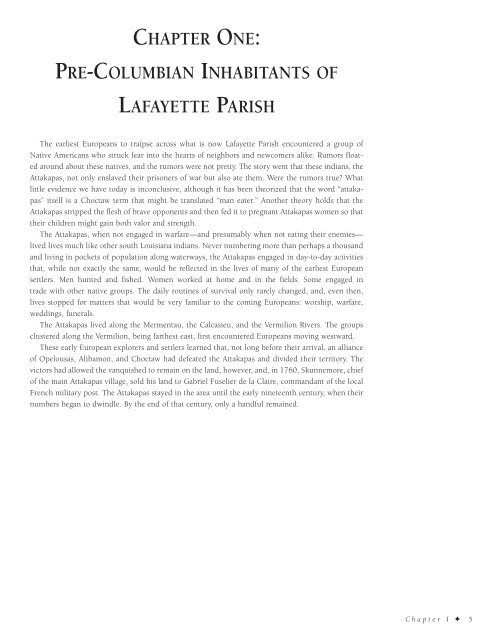Historic Lafayette
An illustrated history of the city of Lafayette and the Lafayette Parish area, paired with the histories of companies, families and organizations that make the region great.
An illustrated history of the city of Lafayette and the Lafayette Parish area, paired with the histories of companies, families and organizations that make the region great.
You also want an ePaper? Increase the reach of your titles
YUMPU automatically turns print PDFs into web optimized ePapers that Google loves.
CHAPTER ONE:<br />
PRE-COLUMBIAN INHABITANTS OF<br />
LAFAYETTE PARISH<br />
The earliest Europeans to traipse across what is now <strong>Lafayette</strong> Parish encountered a group of<br />
Native Americans who struck fear into the hearts of neighbors and newcomers alike. Rumors floated<br />
around about these natives, and the rumors were not pretty. The story went that these indians, the<br />
Attakapas, not only enslaved their prisoners of war but also ate them. Were the rumors true? What<br />
little evidence we have today is inconclusive, although it has been theorized that the word “attakapas”<br />
itself is a Choctaw term that might be translated “man eater.” Another theory holds that the<br />
Attakapas stripped the flesh of brave opponents and then fed it to pregnant Attakapas women so that<br />
their children might gain both valor and strength.<br />
The Attakapas, when not engaged in warfare—and presumably when not eating their enemies—<br />
lived lives much like other south Louisiana indians. Never numbering more than perhaps a thousand<br />
and living in pockets of population along waterways, the Attakapas engaged in day-to-day activities<br />
that, while not exactly the same, would be reflected in the lives of many of the earliest European<br />
settlers. Men hunted and fished. Women worked at home and in the fields. Some engaged in<br />
trade with other native groups. The daily routines of survival only rarely changed, and, even then,<br />
lives stopped for matters that would be very familiar to the coming Europeans: worship, warfare,<br />
weddings, funerals.<br />
The Attakapas lived along the Mermentau, the Calcasieu, and the Vermilion Rivers. The groups<br />
clustered along the Vermilion, being farthest east, first encountered Europeans moving westward.<br />
These early European explorers and settlers learned that, not long before their arrival, an alliance<br />
of Opelousas, Alibamon, and Choctaw had defeated the Attakapas and divided their territory. The<br />
victors had allowed the vanquished to remain on the land, however, and, in 1760, Skunnemore, chief<br />
of the main Attakapas village, sold his land to Gabriel Fuselier de la Claire, commandant of the local<br />
French military post. The Attakapas stayed in the area until the early nineteenth century, when their<br />
numbers began to dwindle. By the end of that century, only a handful remained.<br />
Chapter I ✦ 5
















